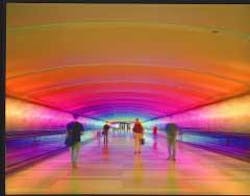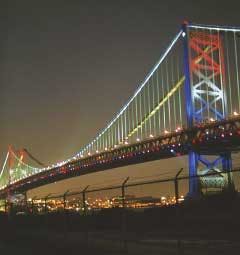Indicators point toward LED general illumination
KEVIN DOWLING
Previously limited by low output to use as indicator signals in electronic devices, light-emitting diodes have been developing at exponential rates equivalent to that of other semiconductor technologies. Performance and pricing trends are analogous to that of semiconductors in general, but light-emitting-diode (LED) technology is already being used in many lighting applications, and many more are yet to come.
While general-illumination white-light sources, dubbed the "Holy Grail" of LED illumination, may be years away, the technology is already widely used in many custom illumination applications. In addition, the long-term goal of general illumination is already possible for many low-luminance applications, with medium-luminance applications right around the corner.
Ultimately, the widespread adoption of LED illumination will not be driven by the LED devices themselves, but by complete solutions and systems that will open up completely new ways of using light, controlling it, and integrating it with other media and materials.
Indication vs. illumination
LED applications that we see everyday—such as traffic lights and brake lights—are examples of indication and not illumination; you look directly at them to see them. General illumination results from sources casting light onto another surface and thus requires higher flux output. Most general illumination that uses traditional lighting sources works in this manner, and now LEDs are moving rapidly into this indirect realm.
Low-priced consumer products such as flashlights, nightlights, and color wands represent a growing category of indirect LED-based lighting. Initially, low-luminance applications such as marker lights and decorative and accent lighting were targeted by LED fixture manufacturers, but in the last two years the advent of higher-flux packages has enabled the use of LED technology in many new products.
The emergence of complete LED-based systems has led to broadening applications within the architectural, theatrical, entertainment, hospitality, display, and signage industries, and is extending this technology to new markets such as residential lighting, landscape lighting, and pool and spa applications. Demand for LED-based lighting has also been driven by the ability to easily and naturally control these light sources, a result of the natural coupling of digital control systems and digital LED-based systems. Voltages, currents, and digital control are very similar in both systems and no intermediate electronics such as dimmers are necessary. This helps the adoption, use, and integration of LED lighting into traditional applications and also opens up new applications.
Architectural lighting
While it was first used in accent lighting to add a touch of color, LED-based lighting is now used in thousands of applications worldwide and, in some cases, provides a large portion of the lighting of spaces such as retail stores, restaurants, nightclubs, casinos, bars, hotels, museums, high-end residential, concert halls, churches, bridges, public spaces, building facades, and much more. In general, customers using LED-based lighting products do not focus on the technical benefits, but rather on the visual effects and ambience they can achieve for their office space, store, brand identity, customer experience, and interior or exterior "mood." They are buying effects or capability, not technology (see Fig. 1). Companies like i2 Technologies (Warwickshire, England), Nortel Networks (Brampton, Ontario, Canada), and Millennium Pharmaceuticals (Cambridge, MA) have installed various applications of LED color-changing light to create unique corporate spaces that reflect their brand and spirit of innovation.
Retail and visual merchandising
Starting with small spot effects and accent lighting for product displays in high-end retail, LED lighting for merchandising has developed into a substantial retail market. The increased use of LEDs in retail applications is fueled by dramatic energy savings—according to the U.S. Department of Energy, lighting accounts for 40% to 50% of energy expenses in commercial applications—low maintenance, and the ability to better attract shoppers. From early high-end users like Saks Fifth Avenue and Harrods, to the increasing adoption by large chains and department stores, LEDs are providing efficient lighting, captivating visual effects, and the ability to differentiate a store's exterior or interior design and product displays (see Fig. 2).Municipal lighting
Bridges are often highly recognizable as the symbol of a city, and the use of color and controllable light offers a chance for a municipality to do more than simply illuminate a structure. The Ben Franklin Bridge in Philadelphia, for example, has close to 400 LED-based fixtures lining the bridge deck and facing upriver and downriver (see Fig. 3). These lights are individually addressable and provide customized light shows based on the season, holiday, or events. They also can be triggered to operate when a train on the lower levels crosses the bridge; such that the lights "chase" the train. Unlike LED-based systems, conventional lighting in this environment would pose an operational problem due to the vibration from passing trains. No traditional filament technology could survive the environmental issues associated with the vibration and the environment.Unlimited possibilities
The most remarkable applications of LEDs are not the simple replacement of existing light sources, but the creative possibilities that are enabling whole new applications and installations. The bulb culture may give way to a new culture of lighting.
Many portable consumer lighting products are already widespread, including flashlights and other personal and environmental lighting products such as nightlights and color wands. These are typically not at the cutting edge of brightness but help drive volumes, production, and new applications.
The use of LEDs is moving into scientific and industrial areas as well. Paul Debevec's work at the University of Southern California (Los Angeles, CA), for example, makes use of digitally controlled light sources to replicate lighting for compositing applications in movie making. A sphere of digitally controlled light sources, called the LightStage, shines inward and can replicate lighting in either computer-generated imagery (CGI) or a "real-life" scene. The sphere can replicate that lighting for the people and action within the LightStage making high-fidelity compositing possible without a great deal of effort in post-production work (see Fig. 4).James Turrell, the internationally known artist who works in the medium of light, said recently that he had been waiting his whole life for LED technology and what it offers. He said he wishes it had been available 30 years ago when he began his work. Turrell has used LED lighting in a variety of architectural spaces including residences, schools, galleries, and buildings throughout the world—transcending the typical lighting arrangements for such spaces.
For many of these applications, LED lighting is being used in conjunction with existing white light sources that provide general illumination. However, the increasing amount of light from LED-based fixtures when combined with general illumination sources is now allowing augmented lighting beyond simple accent or decorative purposes.
Osram Opto Semiconductor (Regensburg, Germany), for example, has created a demonstration office in Europe using LED panels suspended above a conference room table. Color Kinetics has created an office with both traditional fluorescents and intelligent LED-based white-light illumination sources that augment the cool fluorescent light and allow color temperature control of the room lighting. In a collaborative project, Steelcase and IBM have also used LED sources for task lighting with color temperature control as well as indication lighting that signals whether office occupants are available.
Prospects for LED illumination
The lighting market is very large, but the key factor will be the LED adoption rate and not the market size in general. Widespread adoption of LED technology probably won't take place until the cost is at or below the cost of light from traditional sources like fluorescents and incandescents. In the meantime, however, several factors are driving new applications and opportunities in many markets.
Among the most attractive drivers of adoption is the capability of control, which is now being driven in two directions. Control is becoming simpler for the end user with intuitive interfaces and "push of a button" ease. This allows designers and architects to push the envelope with previously unthinkable applications that would have been too complex and time consuming to implement. Second, large-scale and interactive applications with sophisticated behind-the-scenes development now make LED technology easy to use even in the most complex applications. These factors will continue to drive the move into new applications in the coming years.
Kevin Dowling is vice president for strategy and technology at Color Kinetics, 10 Milk St., Suite 1100, Boston, MA 02108; e-mail: [email protected].



